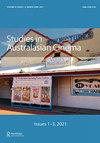Introduction
IF 0.7
0 FILM, RADIO, TELEVISION
引用次数: 0
Abstract
Welcome to this special dossier on ‘Disruptive Narrative Practices’ for the Studies in Australasian Cinema journal. In contemporary screen culture and screen production, we are very familiar with the phrase ‘digital disruption’ which is currently going through exponential upheavals and disruptions with the recent widespread uptake of AI technologies. However, ‘disruption’ in cinema storytelling has a lineage as long as cinema itself. ‘Disruption’ in cinema’s forms and storytelling modes have pushed the boundaries of how narratives are constructed, presented on screen, and disseminated, throughout cinema’s history. In the call for papers for this dossier, we were interested in examining disruption across the spectrum of traditional industry narrative frameworks and script development approaches. We invited essays on disruptive narrative practices in terms of diversity, the border of the factual and the fictive, concepts of authenticity and inauthenticity, intermediality in narrative projects, auto-fiction and the new uses of archival practices in screen forms. The essays selected for this dossier explore disruptions in multiple ways, in experimental films, feature films and television series. In ‘Disrupting the Self: Fictive Dialogic Inquiry into Transformative Screenwriting Practices’, Louise Sawtell and Sue Cake weave the notion of disruption into the form of the essay itself. Drawn from conversations between them conducted on zoom and written up as a lively, informal interchange, the essay critically reflects on their personal experience of script development within the academy. They argue it provides a creative haven for writers to discover new possibilities and reinvent their voice free of the pressures imposed by prescriptive industrial practices. Phoebe Hart brings a similar, personal approach to her essay ‘Playful Hybrids: Documentary Filmmakers Forging Disruptive Narratives’, in which she reflects on her teaching practice in relation to hybrid documentaries. The disruptive docufiction form, which merges fact and fantasy, throws up thorny questions for teachers and students alike: How do you balance creativity and ethics in a period deemed ‘post truth’? What are the practical and ethical challenges of doing so? In her paper, Hart outlines her approach to answering these difficult questions. The theme of disruption and hybridity in documentary continues in Sean Maher and Sue Cake’s ‘Innovation in True Crime Series: Generic Transformations in Documentary Series’. The authors chart how streaming, bingeing, big data and content-based algorithms combined to create a new multi-episode documentary form within the true crime genre. This docuseries form employs narrative conventions from long series介绍
欢迎收看《澳大拉西亚电影研究》杂志关于“颠覆性叙事实践”的特别档案。在当代屏幕文化和屏幕制作中,我们非常熟悉“数字颠覆”这个短语,随着人工智能技术的广泛应用,它目前正在经历指数级的动荡和颠覆。然而,电影故事中的“颠覆”与电影本身一样有其渊源在整个电影史上,电影形式和讲故事模式的颠覆已经突破了叙事如何构建、在屏幕上呈现和传播的界限。在为这份档案征集论文的过程中,我们有兴趣研究传统行业叙事框架和脚本开发方法的颠覆性。我们邀请了一些关于颠覆性叙事实践的文章,涉及多样性、事实和虚构的边界、真实性和不真实性的概念、叙事项目中的中间性、汽车小说以及档案实践在屏幕形式中的新用途。为这份档案选择的文章以多种方式探索了破坏,包括实验电影、故事片和电视连续剧。在《颠覆自我:对变革性编剧实践的虚构对话探究》一书中,Louise Sawtell和Sue Cake将颠覆的概念编织成了文章本身的形式。这篇文章取材于他们在zoom上进行的对话,并以生动、非正式的交流形式写成,批判性地反思了他们在学院内剧本开发的个人经历。他们认为,它为作家提供了一个创造性的避风港,让他们发现新的可能性,重塑自己的声音,摆脱规范性工业实践带来的压力。菲比·哈特(Phoebe Hart)在她的文章《有趣的混合:纪录片制作人打造颠覆性叙事》(Playful Hybrids:Documentary Filmmakers Forging Disruptive Narratives)中也采用了类似的个人方法,她在文章中反思了自己在混合纪录片方面的教学实践。这种颠覆性的纪录片形式融合了事实和幻想,给老师和学生带来了棘手的问题:在一个被视为“后真相”的时期,你如何平衡创造力和道德?这样做的实际和道德挑战是什么?在她的论文中,哈特概述了她回答这些难题的方法。Sean Maher和Sue Cake的《真实犯罪系列中的创新:纪录片系列中的一般转变》延续了纪录片中的颠覆和混杂主题。作者们绘制了流媒体、狂欢、大数据和基于内容的算法如何结合在一起,在真实犯罪类型中创造出一种新的多集纪录片形式。这个文档表单采用了长系列中的叙事惯例
本文章由计算机程序翻译,如有差异,请以英文原文为准。
求助全文
约1分钟内获得全文
求助全文

 求助内容:
求助内容: 应助结果提醒方式:
应助结果提醒方式:


